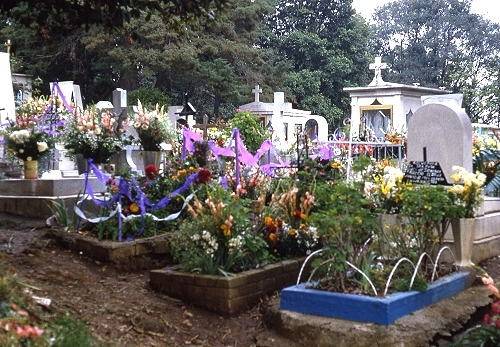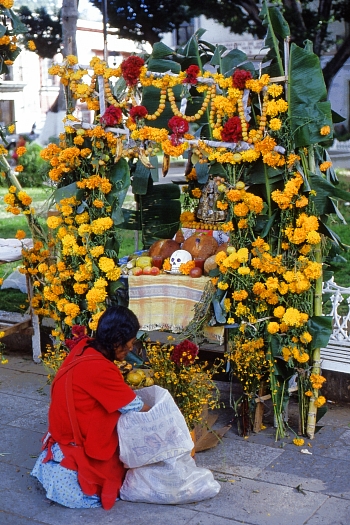The indigenous Mexican peoples held many strong beliefs connected with death; for example that the dead needed the same things as the living, hence their bodies should be buried with their personal possessions, sandals and other objects.
With the arrival of the Spanish, the Indians’ pagan ideas and customs were gradually assimilated into the official Catholic calendar. Dead children are remembered on November 1st, All Saints’ Day, while deceased adults are honored on November 2nd, All Souls’ Day. On either day, most of the activity takes place in the local cemetery.

Children’s graves on Day of the Dead in Santa Rosa Xochiac, Mexico D.F. Photo: Tony Burton; all rights reserved.
Children’s graves have toys placed upon them and are decorated with colorful streamers and balloons. Adult graves are more elaborately decorated with offerings of the departed’s favorite foods and drinks, candles, flowers, and even personal items. Brightly colored Mexican marigolds, or zempasuchitl as the Indians call them, are the traditional flowers used to guide the spirits home. Unusual art forms which appear only at this time of year include richly decorated pan de muerto (bread of death), skull-shaped sugar-sweets, and papier-mâché skeletons.

Finishing touches being put to a Day of the Dead altar, Oaxaca City. Photo: Tony Burton; all rights reserved.
The graves and altars for the Day of the Dead are prepared by the entire family who then stand vigil throughout the night to ensure that their dearly departed recognize close friends or relatives when they come to partake of the feast offered them. The following day, the spirits presumably having had their fill, family, friends and neighbors consume what is left. The village of Janitzio in Lake Pátzcuaro, is perhaps the single most famous place for witnessing Day of the Dead celebrations, but equally interesting observances of the Day of the Dead are held in many small villages elsewhere in Michoacán, off the usual tourist trail. In most of these places, the local Indians are uninfluenced and unaffected by outside contacts.
There are also significant regional variations in the observance of Day of the Dead. The link below is an index to more than forty original MexConnect articles relating to Day of the Dead:
The magic of the traditional decorated altars can also be appreciated by visiting one of the replicas constructed in local museums or cultural centers. You will be looking into the dim and distant pre-Columbian past of Mexico and the Mexican people.
[This is a lightly edited extract from Tony Burton’s Western Mexico: A Traveler’s Treasury (Sombrero Books 2013). Also available as a Kindle e-book.]
Related posts:
- The geography of Thanksgiving: why a Mexican bird came to be called turkey
- Holy Innocents’ Day (28 December)
- Mexican sayings and beliefs, cats and unlucky days
- The Guelaguetza, the major cultural festival of Oaxaca state
- Happy Christmas from Geo-Mexico! Mexico City sets up world’s largest nativity scene…
- Changing customs in Mexico: children forgo Three Kings Day in favor of Christmas Day